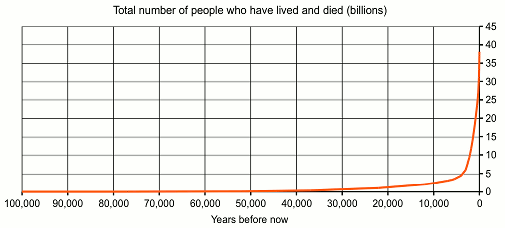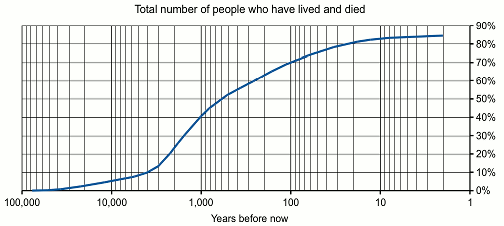
I have been doing a little reading on DNA, evolution and human history, and the implications of the latest science for christian belief (see DNA, genes and human history).
The questions of what do we class as “human”, when the first humans appeared, and how many there were, pose some interesting challenges.
Early humans
We humans (Homo sapiens) are classified as hominins (see note 1), a small branch of the primates. We are descended from earlier primates such as Australopithecus (4 million to 2 million years ago). About 2 million years ago, the first Homo species appeared in Africa: Homo habilis, Homo rudolfensis and Homo ergaster. These, and descendent species such as Homo erectus, used tools and fire, and began to spread out from Africa into Asia and Europe.
By around 250,000 years ago, the Neanderthals (Homo neanderthalensis) had also migrated out of Africa and replaced the earlier Homo species across Asia and Europe. But then, about 200,000 years ago, Homo sapiens appeared and sometime less than 100,000 years ago also migrated out of Africa, across all of Asia and eventually to Australia and the Americas. Homo sapiens had a greater brain capacity, and by about 30,000 years ago the Neanderthals were extinct.
What is human?
So which Homo species were the first humans? Biologically, the changes were gradual, and the answer may be arbitrary – some would say all the Homo genus, some say that the species before the Neanderthals were “not fully human”, while others say only Homo sapiens are human.
But for christians, being human is more than biology, and involves a spiritual and ethical capability, and the ability to make free choices. From this perspective it is impossible to say when and if these capabilities evolved. Some christians (for example, Francis Collins and others at BioLogos) believe that these aspects of humanity were “gifted” by God when the Homo genus had developed sufficiently. When this may have occurred is another difficult question, but somewhere in the period 80,000 to 100,000 years ago, sometime before they migrated out of Africa, would seem the most popular choice.
Why did God wait so long?
God didn’t seem to be in a hurry to get from the creation of the universe at the big bang, and the appearance of the first human beings – about 13-14 billion years. But then again, he had all the time in the world!
But a more difficult question is: why did God wait 90,000-100,000 years, from the first human being to his intervention in Jewish history about 2000 BCE? Christopher Hitchens, for example, made a point of this – why leave people suffering and in the spiritual dark for so long?
Of course there are some assumptions here, for example that God left them in the dark – we don’t know if or how God may have involved himself with these early Homo sapiens. But there is another problem with Hitchens’ assumptions.
How many humans?
Hitchens’ argument is based on time, but of course the important question is: How many people were affected?
The only answer I could find was from the Population Reference Bureau, but it had some problems (see ‘The data’ below), so I therefore decided to do a revised estimate.
I obtained estimations of population and life expectancy and entered these figures into a spreadsheet with 30 time periods between 100,000 years ago and now. The calculation is simple.
- For each time period, the average number of lifespans is the length of time divided by the life expectancy.
- The estimated number of people dying in that time period is the number of lifespans times the average population.
- Cumulating these figures gives the total number of people who have lived and died up until each time.
- Add in the total still living now, and we get the total number of people who have lived.
The result is shown in the graph above, which shows how the total number of people who have lived and died rises sharply in the last 3,000 years. But more useful is the graph below which uses a reverse logarithmic scale. The model gives the following results can be shown (for comparison, figures from the PRB are shown in brackets):
- The total number of people who ever lived was estimated as about 45 billion (PRB: 108 billion).
- The 7 billion people living today comprise 16% of the total number of “humans” since 100,000 years ago (PRB: 6%).
- More than three quarters of all people (77%) have lived since Jesus (PRB: 56%).
- Only 10% of all people lived in the long pre-Abraham period (100,000 to 4,000 years ago) identified by Hitchens (PRB:12%).

Conclusions
The data
The large discrepancy in my figures and those from PRB show how much the numbers are sensitive to assumptions, and are caused by several factors:
- Both models are based on life expectancy, but the PRB figures estimate the births and while mine estimate deaths. This makes only a small difference, as the two sets of figures are slightly displaced.
- The PRB model is very coarse in the early days (one time interval covers from 8000 BCE to 1 CE), creating some large inaccuracies and requiring difficult interpolation (you can’t draw straight lines on a population growth graph!).
- The main difference is an enormous difference in life expectancy for prehistoric humans – PRB uses 10-12 years only, with the average brought down by high infant mortality, whereas most other sources (see References below) suggest the best estimate is around 30 years, while a few suggest around 20 years.
I therefore believe the PRB estimates are too high. But, for our purposes, the difference isn’t so important, because the two datasets give almost the same result for percentage of people who lived before 2000 BCE – 10% or a little more.
The Hitchens’ claims
The numbers are obviously very approximate. Nevertheless, Hitchens’ argument is shown to be not nearly as strong as it first seems. While there was a long time span, it wasn’t a large number of people (relatively).
Some christians are “exclusivists”. that is, they believe only those who have specifically chosen to put their faith in Jesus will be “saved” (though they presumably make an exception for faithful Old Testament Jews). But “inclusivist” christians believe that while Jesus is necessary for salvation, God only requires that people everywhere respond to the light they have been given. (There are hints of this in the Bible, and famous christians such as CS Lewis and Billy Graham apparently took this view.)
If the exclusivists are right, the 10% of people before Abraham have a problem, but if the inclusivists are right, they have no more problem than anyone else.
References
- Background information on early hominids: Wikipedia on Neanderthals, Early human migrations and the Homo genus. BioLogos on The rise of early Homo, Evolution of early Homo, Out of Africa (the first time) and Neanderthals, Denisovans and Human Speciation.
- Francis Collins and BioLogos.
- Population estimates: US Census Bureau and Wikipedia.
- Life expectancy estimates around 30 years: Encyclopedia of Health, Mark Nathan Cohen, Prehistoric Waterford (Ireland), Journal of the Royal Society of New Zealand, Wikipedia, NBC News, several sources quoted by Sébastien Noël and Health Guidance.
- Life expectancy estimates around 20 years: Encyclopedia of Prehistory, Piero Scaruffi and Ian Arthur Colquhoun.
- Population Reference Bureau.
Note 1: According to the Australian Museum, hominids are all modern and extinct Great Apes (that is, modern humans, chimpanzees, gorillas and orang-utans plus all their immediate ancestors) whereas hominins are a sub-group consisting of modern humans, extinct human species and all our immediate ancestors.
Thanks for putting in so much time to research this!
That’s indeed an impressive amount of work for a topic I wouldn’t bother to research! There is one thing I do not understand, though:
“For each time period, the average number of generations is the length of time divided by the life expectancy.”
Shouldn’t the average number of generations be the length of time divided by the average age of giving birth? I understand such figures may be particularly hard to get by, but if life expectancy is used, there is likely to be an underestimate of the average number of generations. After all, humans are not black widows.
“Shouldn’t the average number of generations be the length of time divided by the average age of giving birth?”
Dang! Thanks for that. I think you are right in your critique, but incorrect in your solution. It is more complex than I thought, for 2 reasons.
1. The average age of giving birth only addresses those who live that long, whereas life expectancy includes everyone, including infant mortality.
2. The most solid estimation is population at any one time, and that is used to estimate the number of individual lifespans. But population is made up of people both before and after child-bearing age. I can see that basing on births, as PRB did, is better than my basing it on deaths.
I will have to reconsider, modify my model and edit the post. It will certainly move my figures closer to PRB’s, though I still think they have understated expectancy just as I have overstated the length of generations. I have emailed PRB asking for clarification of a few things, so we’ll see if they reply.
Back to the drawing board!
Well, I spoke too soon. Having given it all a little more thought, and running a few simulations, I now think I was “right” all along. The misunderstanding is caused by my ill-advised use of the word “generations” when I should have said “lifespans”.
Think of it like this. Suppose over a 100 year period, a tribe grows from 90 to 110, average 100. Then over that century, 100×100 = 10,000 person years were lived. If the average person lived for 30 years (i.e. life expectancy = 30), then the number of people required to make up that 10,000 person-years = 10,000/30 = 333, which is the calculation I am doing. This calculation has nothing to do with generations and date at birth.
Now it is still very approximate, and I still think basing the calculation on births rather than deaths is a better way to go, but I don’t have the birth rate data, and I can’t find it.
So I will make a couple of changes of words, but otherwise I think the post can stand – unless you can show me I’m still wrong. Thanks for the stimulating challenge.
Then the problem is solved. I interpreted “average number of generations” as the average number of generations born. Then it makes sense to find out what the average age of giving birth is, because then it is known how long it will take on average for a new generation to be born and thus how many generations there could have been on average within a given time period.